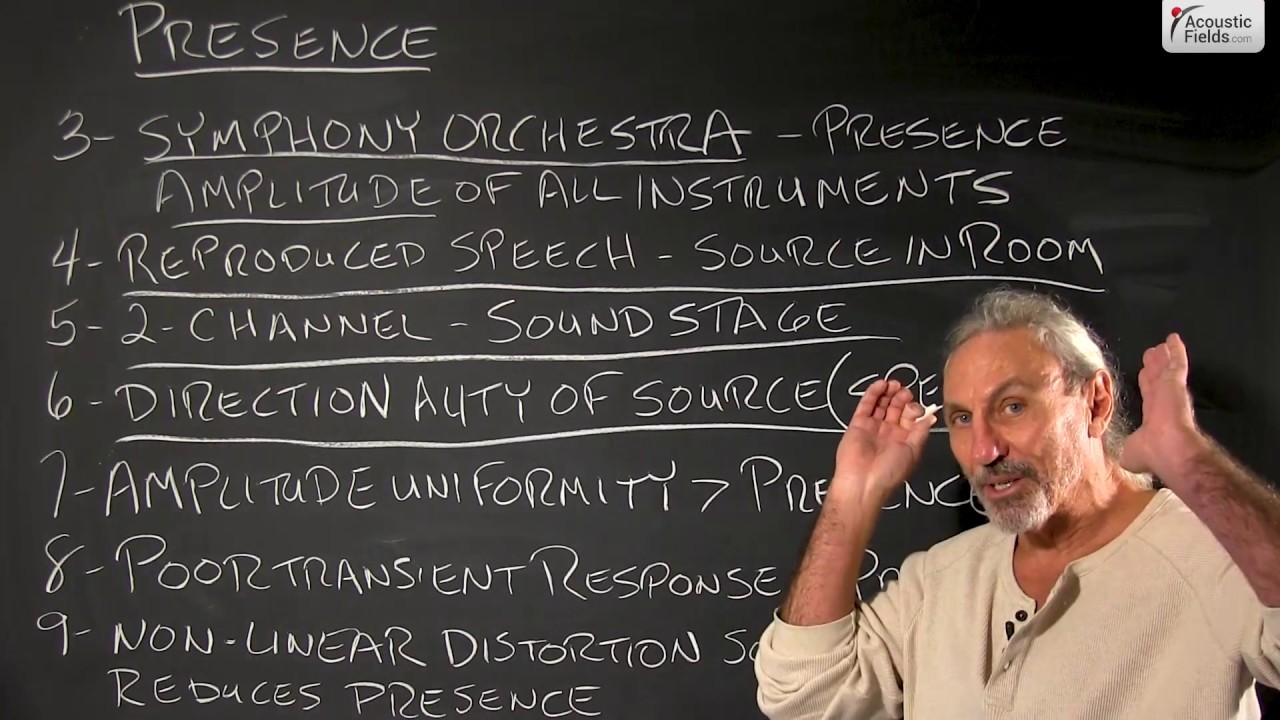Presence. We all hear this word bounce around a lot in the literature. But let’s try to use some examples and put some meaning to the term because I think it’s confusing to some people. And boy, I’ll tell you I’ve been in a lot of rooms where I don’t hear any presence at all.
So it’s a psychological term. It’s a type of intimacy that we get with live and reproduced music. Now, let’s break down the scientific aspects of that subjective thing, that feeling of intimacy and realize that it’s related to amplitude and frequency, okay?
So we’re going to address the relationship between those. We’re going to have less intimacy maybe with the lower frequencies than we are in the middle and the high. It has to do with a lot of things, mainly our ear and hearing mechanisms.
So frequency and amplitude, the strength is important. The transient characteristics between all of this energy that we experience. Distortion characteristics. Distortion can be very, very detrimental in terms of presence and that intimacy that we’re trying to create. It’s kind of like running your finger. You can’t do it on this, probably because it’s not slate. But when you run your fingernail across the blackboard, that’s distortion and that will take care of any intimacy we have in any presentation, believe me.
So spatial arrangement. How does everything fit? Between itself, between the notes, between the fundamentals, between the harmonics and in the room itself, okay?
The directional pattern of the sources. Alright? Are we being flooded with the information from front sound fields? Is it sides? Is it rear? Is it overhead? And that’s where these home theater systems I think lack. That kind of situation, that presence. I know they try to give it to us with these multiple sources bombarding us with information. But the multiple model sources throwing energy at you from all different directions, our hearing is not set up to receive that kind of information and we definitely lose presence. So it’s manufacturer’s way of overcompensating, I think, for something that naturally can occur if we look at the characteristics of presence.
So reverberation and resonant characteristics of the space always gets back to that. And that’s why I’m very critical about room size and volume for usage. And this is one of the reasons for that. Because there’s a scientific and a physical reason why you can’t hear presence in some rooms and another.
Let’s look at some definitions now of presence. And we can look at a symphony orchestra because I really like to use this kind of energy to illustrate things. There’s a presence if all the instruments are of the same strength. There’s real good balance. If the drums and the tympanies and percussion sections and the tubas are way overbalanced or way too much energy for the rest of the instruments, we lose presence. Because we have this ability in our brains, in our hearing system to localize these kind of differences. It’s part of our spatial recognition system that we use for distance in rooms.
So we do a funny thing in our studio. We blindfold people and we ask them to guess distance between walls that have diffusion and don’t and it’s funny. We’ll do a video on that sometimes so you can see the differences. They range from 25% air to 200-300-400% air. So it’s kind of funny to see how people’s different hearing systems go but amplitude must be the same, okay?
Reproduced speech, if we have a person in the room speaking. There’s much more presence as in terms of being a receiver in the audience than there is if the person is on TV, on a video screen with the remote, okay?
Two-channel, we are familiar with that. That’s a sound stage. Boy, we’re really trying to get our presence going there, right? So the directionality of source is critical, the speaker. We know in two-channel when we set up we have to have our triangle, so that the distances are good because of the time signature of sound travel.
So we know that all those things have to be equal. But where the information is coming from is really critical in terms of presence and being involved. And what is this about? Well, think about it. We’re designed to face our source. Look at our ears. So when we face our source all of these things come into play. The speaker’s behind us, we don’t have that same kind of presence, okay?
So we have to have amplitude uniformity to get greater presence. If we have poor transient response in our speakers, in our electronics we have less presence. Just ask any speaker manufacturer on that one. And then of course the old bugaboo in the whole system and that’s distortion. I think non-linear distortion – I think by definition all distortion is not linear. So sound system reduces presence. Any kind of distortion in there reduces presence. Why? Because our brain localizes on that.
So hope this helps. Presence is a really good variable to go for in your music, don’t hear it a lot in systems today. You can get it with the right room size and volume and the right treatments and the right kind of planning and strategy to accomplish your goals.
—
This is an unedited transcript from our video series from Acoustic Fields. There will be some errors in grammar and sentence structure that occur during this translation process.
For complete understanding and comprehension, please view the video which is included in this text. For any additional information regarding this topic or others relating to room acoustics, please contact us directly at:
P: 520 – 392 – 9486







